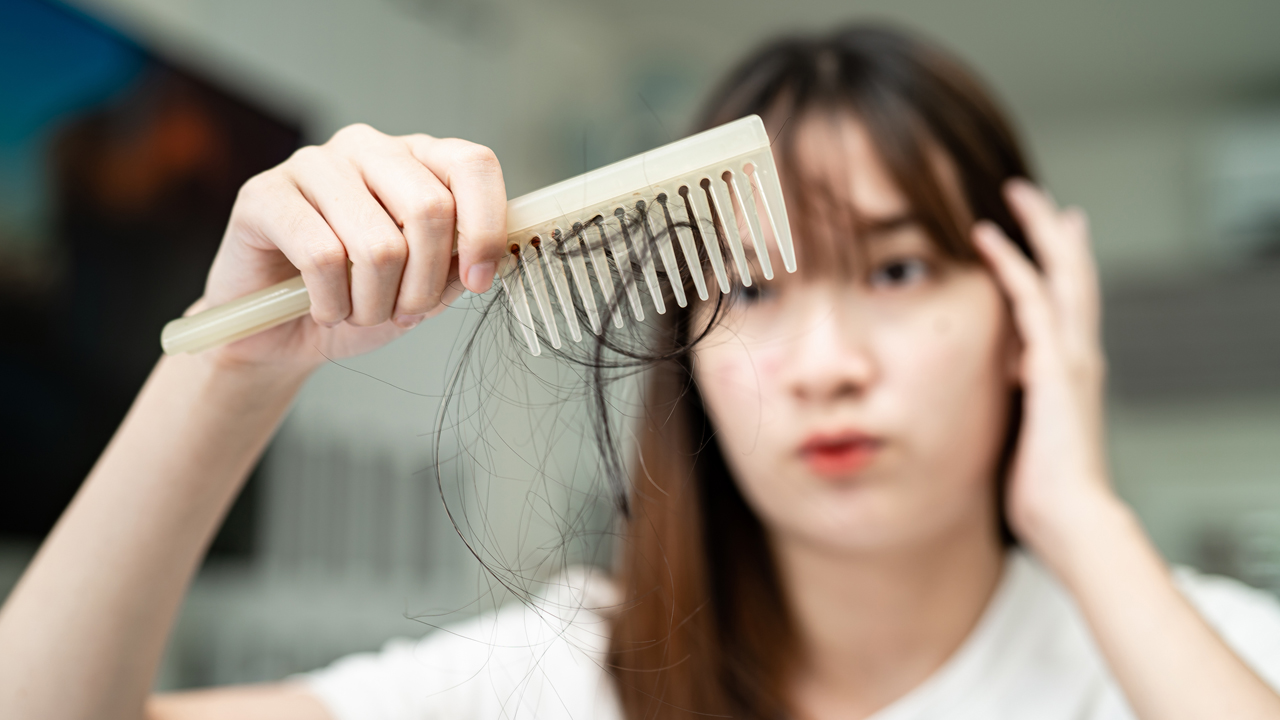In OTC
Follow this topic
Bookmark
Record learning outcomes
According to Mordor Intelligence, the UK hair care market is projected to grow at a rate of 4.5 per cent over the next five years.
Increased concern about scalp health – especially hair thinning, hair loss, dandruff and scalp sensitivity – is driving the market.
Hair and scalp conditions affect people of all ages, and can be very noticeable and difficult to hide. They can often be treated with self-help measures and over-the-counter medicines, yet many people are too embarrassed to seek advice.
Stephanie Sey, expert trichologist for Nizoral, says: “Consumers looking for products to help with scalp conditions such as dandruff may feel distressed or frustrated due to symptoms being typically ‘embarrassing’ and the preconception that if someone has dandruff, it means they are dirty or unkempt. Those suffering from dandruff may experience low self-esteem and feel humiliated by their condition.”
Seborrhoeic dermatitis in children
Seborrhoeic dermatitis is common in babies and young children, and usually appears in the first six weeks of life. It causes redness and yellow scales on the scalp, sometimes affecting the eyebrows, face and nappy area. Unlike atopic eczema, it’s not itchy, uncomfortable or painful, although it can look unsightly. It’s important to reassure parents that this will usually clear up within a few months.
According to Eva Proudman, consultant trichologist at www.ukhairconsultants.com, seborrhoeic dermatitis in children has various causes. “It can be genetic (inheriting conditions such as eczema and asthma),” she says, “or caused by an overactive yeast that lives naturally on the skin, shampoos and hair/scalp care, cold weather and even diet. In very young children, it’s called ‘cradle cap’, moving to seborrhoeic dermatitis in toddlers and above. The best way to manage this is with a really good shampoo and frequency of washing – daily washing is ideal.”
Parents should massage a topical emollient into the child’s scalp to loosen the scales, brush gently with a soft brush and wash off with shampoo. If this fails to work, a GP may prescribe an antifungal cream.
This is an important area for our pharmacy. Queries we normally get are to do with dandruff when it’s adults, cradle cap for babies and headlice for children. Our most popular headlice treatment is Hedrin Once as parents like the fact that it’s quick. For dandruff, Nizoral and T-gel shampoo are our best sellers. For cradle cap, it’s Dentinox. We’ve been getting more requests about treating headlice over the last year and I think that’s a result of social mixing going back to normal after the pandemic, when we saw far fewer cases. For display, I would suggest you put the GSL products for this category in accessible areas for customers, ideally at eye level, and use shelf edgers to promote it.
Seborrhoeic dermatitis in adults
Seborrhoeic dermatitis is a chronic inflammatory condition that affects around one in 20 adults.
It causes a flaky rash on greasy skin areas that are rich in sebaceous glands, such as the scalp, sides of the nose, ears, eyebrows, chest and skin folds. The rash may look red or lighter or darker than the surrounding skin, depending on the skin type and skin colour. The flakes may look like dandruff. The symptoms vary from person to person, but may be worsened by tiredness, stress and cold, dry weather.
The cause of seborrhoeic dermatitis isn’t clear, although high amounts of the harmless yeast Malassezia can be found on the skin of people who have the condition. It’s thought that the inflammation may be due to a breakdown of the skin barrier and increased sensitivity to oleic acid, which is produced by the yeast.
Seborrhoeic dermatitis symptoms often flare up and down. Some people need daily treatment, while others just treat occasional flare-ups.
Treatments for mild to moderate symptoms are available over the counter and may contain antifungal ingredients such as ketoconazole or piroctone olamine. “Most cosmetic shampoos and hair care don’t treat the root cause of dandruff,” says Sey. “Ketoconazole is an antifungal agent that stops the growth of the yeast Malassezia, which is a contributing factor to dandruff. Ketoconazole can therefore help control and effectively treat the cause, as well as the symptoms.”
If the rash is widespread or isn’t clearing up with treatment, customers should be referred to their GP. They may need topical corticosteroids, or newer topical calcineurin inhibitors, which are safer to use for longer periods.
This is not a massively important category for our pharmacy, since most anti-dandruff coal tar treatments and fungal scalp treatments are available on the NHS in Wales. Questions typically revolve around how to use medicated shampoos for and how long they can take to work. Neutrogena T gel is always a trusted favourite, as well as Oilatum Scalp Shampoo in our pharmacy. We’ve noticed a trend for more people looking for self-care remedies over going to the doctor these days. Have your team available and trained to go over how specific products are to be used to ensure your customer is getting the most out of their treatment.
Hair loss and hair thinning in men
Male pattern hair loss (androgenetic alopecia) is the most common type of hair loss in men. It affects around one in two men over the age of 50, but may be noticeable at any time after puberty. The hair loss usually begins at the front and sides of the scalp, and then progresses towards the back of the head. Bald patches should be covered with sun block, a wig or a hat to protect them from strong sunlight.
Androgenetic alopecia is caused by a combination of genetic and hormonal factors. It’s thought that in susceptible men, hair follicles become more sensitive to dihydrotestosterone (DHT).
This androgen hormone makes the hairs progressively smaller in diameter, shorter in length and lighter in colour, until eventually the follicles shrink completely and stop producing hair.
Hair loss in men can affect self-esteem and socialising, and men may become frustrated at the limited treatment options. Some men may choose to wear wigs or hair pieces to disguise hair loss. Surgical treatments, such as a hair transplant, are not available under the NHS. Medicines won’t reverse hair loss completely.
Hair loss in men may be treated with topical minoxidil to slow down the progression of hair loss and partially restore hair growth. This medicine isn’t available on an NHS prescription, so it can be expensive. The liquid or foam needs to be applied to the scalp, not the hair, for at least six months to see any benefits. Minoxidil solution may cause initial hair loss in the first few weeks of treatment, but this should subside. It can cause skin reactions, such as dryness, redness, scaling and itching, and shouldn’t be applied to cuts or open wounds. An alternative medicine is finasteride, which reduces levels of DHT. These oral tablets need to be taken continuously for three to six months, and may lead to decreased libido and erectile problems.
“We use topical minoxidil at a strength of 5% twice daily, and also DHT blockers such as finasteride taken at 1 mg daily,” says Proudman. “There’s a natural alternative DHT blocker from the saw palmetto plant that doesn’t have the same side effects as finasteride, and for younger men this is sometimes a preferred option.”
All medicines for hair loss will only work for as long as they are continued – the hair loss will return within six to 12 months after discontinuing treatment.
This is certainly an important and common topic. Typically, we get a variety of hair and scalp conditions, from seborrheic dermatitis to psoriasis. However, head lice has become increasingly common. Patients are especially conscious that it can spread quickly to those around them. Therefore, they typically come in to ask what they can do to treat the condition. Any wet combing product sells well in this case – for example, the Bug Buster kit and the NitFree comb. This is used in combination with a dimeticone 4% lotion such as Hedrin. To improve sales, it is useful to sell the comb and medicinal products next to each other and to offer deals to buy both in one purchase.
Hair loss and thinning hair in women
If women experience hair loss or hair thinning at any age, they should be referred to their GP to check for underlying conditions. Hair loss or hair thinning may be associated with nutritional deficiencies (such as iron), thyroid problems, diabetes, autoimmune conditions (such as lupus) or polycystic ovary syndrome (which also causes acne, increased facial hair, irregular periods and infertility).
“We advise blood tests to check there are no deficiencies underpinning extra hair fall, and take a detailed case history to ensure there are no lifestyle factors that may be exacerbating the hair loss,” says Susie Hammond a consultant trichologist at Philip Kingsley.
Proudman says it’s important to distinguish between hair loss and hair thinning. “I would always ask a client if there is a lot of hair falling out in the shower/during brushing, with it feeling significantly thinner in the mid lengths to ends,” she says. “In this instance, it could be telogen effluvium, an imbalance to the growing and shedding cycle, causing the hair to fall out more quickly than is normal then re-grow and shed again.”
Female pattern hair loss/thinning becomes more common at the menopause. As with male pattern hair loss, it is caused by a combination of genetic and hormonal factors. There is widespread thinning, mainly on the scalp. The hairline usually looks normal, but the affected hairs become thinner and shorter until they disappear completely. Female pattern hair loss rarely causes areas of total hair loss, and shampooing won’t make the hair loss worse.
Some women decide to use hair pieces, wigs and scarves or hairstyling, colouring and hairsprays to disguise hair thinning or hair loss. Minoxidil 2% topical solution or 5% foam can be bought over the counter or prescribed privately. Applying these daily may help to restore some hair growth, but women need to wait six months before they see any significance benefits. Stopping the treatment will result in hair loss again. If minoxidil doesn’t work, or women are worried about their hair thinning/loss, they should be referred to a consultant dermatologist or trichologist.
It is also important to address the psychological impact of hair loss – women can be referred to local support groups and counsellors for peer-group support
and counselling.




